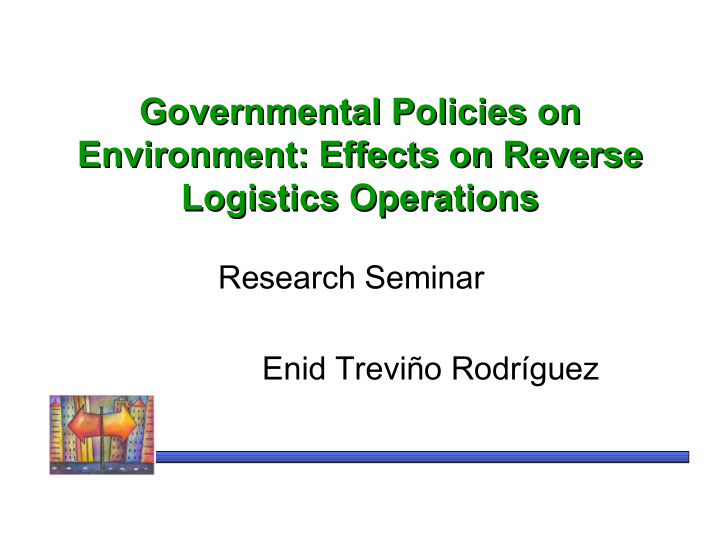



Governmental Policies on Governmental Policies on Environment: Effects on Reverse Environment: Effects on Reverse Logistics Operations Logistics Operations Research Seminar Enid Treviño Rodríguez
Outline Outline Introduction Reverse Logistics International Environmental Regulations Types of Policies Information dissemination and use mechanisms Economic “Sticks” Producer Responsibility “Carrots” Legislative “Sticks” Effects of Policies and RL Conclusions
Introduction Introduction Reverse Logistics is becoming an important business all around the world. More companies are now aware of its importance… but What is Reverse Logistics and why has it become so important recently?
Definition Reverse Logistics (RL) is the process of planning, implementing and controlling the efficient, cost-effective flow of raw materials, in-process inventory, finished goods and related information from the point of consumption to the point of origin for the purpose of recapturing value or proper disposal. Defined by The Council of Logistics Management
Companies’ Interest in RL Companies’ Interest in RL Although many companies are now making serious investments in their RL systems, many other companies do not want to implement recovery activities or they are only prepared to implement them in a very inefficient way.
Environmental Regulations Environmental Regulations Both literature and practice suggest that RL activities will soon be an obligation and not just an option. Over the last years, new environmental laws have introduced the producer responsibility.
Environmental Regulations: EU Environmental Regulations: EU In 2003, the European Union (EU) approved the legislation to establish an EU-electronic waste management infrastructure (WEEE) and restricted the use of certain hazardous substances in high-tech equipment (RoHS)
Environmental Regulations: EU Environmental Regulations: EU EU is taking measures to prevent the generation of electrical and electronic waste and to promote reuse, recycling and other forms of recovery in order to reduce the quantity of such waste to be eliminated.
Environmental Regulations: EU Environmental Regulations: EU The European Union wishes to prevent waste from end-of-life vehicles and promote the collection, re-use and recycling of their components to protect the environment
Environmental Regulations: China Environmental Regulations: China The Chinese Government initiated four major environmental policy initiatives that affect the energy efficiency, hazardous material content, and end-of-life disposition of high-tech products, as well as the collection and recycling of spent batteries.
Environmental Regulations: Mexico Environmental Regulations: Mexico The General Law of Ecological Equilibrium and Environmental Protection (LGEEPA) 1988 defines the environmental legislative model applied until today.
Environmental Regulations: Mexico Environmental Regulations: Mexico In 2003 the General Law For Integral Management and Reduction of Waste was approved
Types of Policies Types of Policies Information dissemination and use mechanisms Economic “Sticks” Producer Responsibility “Carrots” Legislative “Sticks”
Information dissemination and use Information dissemination and use mechanisms mechanisms Coordinated publicity Education programmes Technical assistance Training programmes
Economic “Sticks” Economic “Sticks” Deposit refund systems. Raw material tax. Waste disposal tax. Non-recyclable goods tax.
Producer Responsibility Producer Responsibility The “producer” of goods that produce waste takes responsibility for those waste, rather than expecting society to pay for waste collection and disposal.
“Carrots” Carrots” “ Subsidies for: Waste prevention programmes. Research and development. New central treatment facilities. Developing the demand of recycled materials.
Legislative “Sticks” Legislative “Sticks” Restrict the availability of landfill Mandatory separate collection and recycling programmes System of licensing for storage, treatment and disposal facilities
Effects of Policies Effects of Policies If it is necessary to fulfill regulations, then managing the flows of spent products has become a priority for manufacturers and importers. Manufacturers have to deal with the collection and recycling of their products even if no profit can be expected
Effects of Policies Effects of Policies Companies will have to comply with new environmental legislation but there is no need to do it inefficiently. A careful economic analysis is needed to determine the best way to perform RL activities.
Conclusions Conclusions The broad scope and strict nature of these environmental policies will impact: Product design and innovation Cost Processes
Bibliography Bibliography 1. Management and Research, 14, 385-398, 1996, David C. Wilson, STICK OR CARROTS? : THE USE OF POLICY MEASURES TO MOVE WASTE MANAGEMENT UP THE HIERARCHY. 2. Supply Chain Management and Reverse Logistics, 35-59, 2004, Frank Schultmann, Moritz Zumkeller, Otto Rentz, INTEGRATING SPENT PRODUCTS´ MATERIAL INTO SUPPLY CHAINS: THE RECYCLING OF END-OF-LIFE VEHICLES AS AN EXAMPLE. 3. California Management Review, Vol. 46, 23-39, 2004, Harold Krikke, Ieke Blanc, Steef van de Velde, PRODUCT MODULARITY AND THE DESIGN OF CLOSED-LOOP SUPPLY CHAINS.
Bibliography Bibliography 4. Supply Chain Management and Reverse Logistics, 13-34, 2004, Harald Dyckhoff, Rainer Souren, Jens Keilen, THE EXPANSION OF SUPPLY CHAINS TO CLOSED LOOP SYSTEMS: A CONCEPTUAL FRAMEWORK AND THE AUTOMOTIVE INDUSTRY´S POINT OF VIEW. 5. Supply Chain Management and Reverse Logistics, 35-59, 2004, Frank Schultmann, Moritz Zumkeller, Otto Rentz, INTEGRATING SPENT PRODUCTS´ MATERIAL INTO SUPPLY CHAINS: THE RECYCLING OF END-OF-LIFE VEHICLES AS AN EXAMPLE. 6. http://www.semarnat.gob.mx/informacionambiental/Pages/sniarn.aspx 7. http://europa.eu/scadplus/leg/en/lvb/l21210.htm 8. http://www.greensupplyline.com/news/ 9. http://www.epa.gov/
Recommend
More recommend